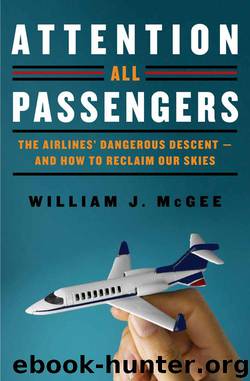Attention All Passengers by William J. McGee

Author:William J. McGee
Language: eng
Format: mobi, epub
Publisher: HarperCollins
Published: 2012-07-01T04:00:00+00:00
An Outsourcing Outbreak
The latest numbers are hard to uncover, but there’s no question that outsourcing keeps increasing. According to the Aeronautical Repair Station Association, the maintenance repair and overhaul (MRO) market annually exceeds $50 billion worldwide. Within the United States, ARSA claims the industry has grown to 200,000 employees at 4,200 firms, but small- or medium-sized enterprises constitute 85 percent of this total.
In September 2008 the DOT’s inspector general issued a detailed report on aircraft maintenance outsourcing and noted that nine of the ten largest U.S. carriers were outsourcing 71 percent of their “heavy” maintenance and repairs, up dramatically from 34 percent in 2003. Also, 907 repair stations were performing heavy maintenance for the largest domestic carriers. Of these outside facilities, 661 were located in the United States, while 81 were in Central America, 79 in Asia, 69 in Canada, and 17 in Mexico. (The United States and the European Union have a reciprocal oversight agreement—a “transatlantic NAFTA”—so European work is not included.) Overall, the FAA had certificated a total of 4,159 domestic and 709 foreign repair stations by July 2008, an avalanche of new outposts.
But even these numbers don’t tell the whole story. Incredibly, regulations allow U.S. airlines to voluntarily provide such data. Also, these voluntary requests cover only their “top ten substantial maintenance providers,” even if an airline has hundreds. The IG found that reporting system to be “inadequate” and bluntly stated that the FAA “still does not have comprehensive data on how much and where outsourced maintenance is performed.” There’s no question the outsourcing percentages are climbing even higher today.
The IG redacted airline names, but among its other findings was that over a three-year period, FAA maintenance inspectors assigned to one airline visited only four of its fifteen most substantial maintenance providers. In another case, a major foreign engine repair facility was not visited by the FAA until five years after the FAA approved it for repairs; such an inspection should have occurred immediately. And one maintenance vendor continued performing work despite failing to respond to a total of sixty red-flag open corrective action reports that had exceeded the required response time windows. Yet despite agreeing to a specific recommendation in 2003, by 2007 the FAA still was not properly identifying 33 percent of outside repair stations in its database.
As for oversight, it’s mostly the scout’s honor system. The FAA relies heavily on air carriers’ oversight, and audit programs are not always effective. The regulations are quite loose about when problems need to be addressed, and violations can be resolved simply based on written pledges from the outside repair stations! In fact, the FAA does not require its maintenance inspectors to conduct on-site inspections of outside repair facilities prior to or even after approval of those stations—even when problems are found.
What’s more, there’s plenty of blame to go around. The IG report stated: “At one heavy airframe repair station, all three types of oversight failed—FAA, air carrier, and repair station.” In other words, the system is not working from top to bottom.
Download
This site does not store any files on its server. We only index and link to content provided by other sites. Please contact the content providers to delete copyright contents if any and email us, we'll remove relevant links or contents immediately.
| Airport | Commercial |
| Helicopters | History |
| Pictorial | Piloting & Flight Instruction |
| Repair & Maintenance |
Small Unmanned Fixed-wing Aircraft Design by Andrew J. Keane Andras Sobester James P. Scanlan & András Sóbester & James P. Scanlan(32763)
Navigation and Map Reading by K Andrew(5133)
Endurance: Shackleton's Incredible Voyage by Alfred Lansing(4719)
And the Band Played On by Randy Shilts(2165)
The Box by Marc Levinson(1965)
Top 10 Prague (EYEWITNESS TOP 10 TRAVEL GUIDES) by DK(1957)
Wild Ride by Adam Lashinsky(1951)
The Race for Hitler's X-Planes: Britain's 1945 Mission to Capture Secret Luftwaffe Technology by John Christopher(1837)
The One Percenter Encyclopedia by Bill Hayes(1811)
Trans-Siberian Railway by Lonely Planet(1725)
Girls Auto Clinic Glove Box Guide by Patrice Banks(1707)
Bligh by Rob Mundle(1676)
Looking for a Ship by John McPhee(1651)
Good with Words by Patrick Barry(1641)
Batavia's Graveyard by Mike Dash(1633)
TWA 800 by Jack Cashill(1625)
Fighting Hitler's Jets: The Extraordinary Story of the American Airmen Who Beat the Luftwaffe and Defeated Nazi Germany by Robert F. Dorr(1610)
Troubleshooting and Repair of Diesel Engines by Paul Dempsey(1578)
Ticket to Ride by Tom Chesshyre(1567)
